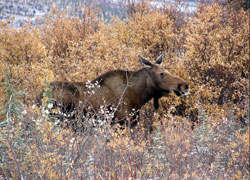Wildlife Habitat Enhancement Projects
Overview
Department of Wildlife Conservation staff work with landowners and land managers to implement a habitat enhancement program. An active habitat enhancement program is needed to mitigate the impacts of human development on wildlife and respond to a growing desire to observe and harvest wildlife. This is particularly true near populated, road accessible areas of Alaska.
Prescribed Burns, Scarification, Crushing, Planting

Prescribed burns are fires intentionally started under specific conditions to simulate wildfires. Prescribed burns are used as a management tool to enhance wildlife habitat. Often prescribed burns are also designed to break up large expanses of black spruce forest (reduced risk of widespread crown fire) or reduce the amount of fuel built up on the forest floor (reduced potential for severe fires), particularly near communities.
Mechanical treatments may be applied as part of forestry operations or as stand-alone silvicultural
practices to regenerate specific types of vegetation for habitat objectives. Scarification is exposure
of mineral soil for germination of trees or shrubs from seedfall, often done with dozer blades or
special disking devices after timber harvest. Using dozers to crush or shear willows, or deciduous
trees like aspen, is a technique to cause prolific sprouting of young plants from an intact root system.
Top killing the woody vegetation simulates natural disturbance, such as ice scouring along rivers or
low-severity (shallow burning) spring fires on upland sites. Finally, planting of willow cuttings can
be used to reestablish willows in logging areas where sunlight warms the soil, although it is relatively
labor intensive (costly per acre).
While many habitat projects have been implemented in past years, recent and planned projects
are described in more detail here.
